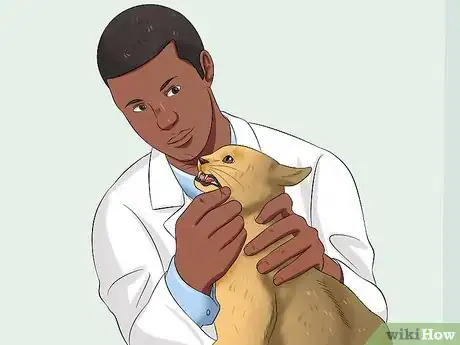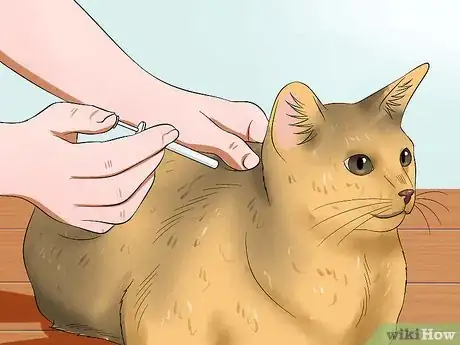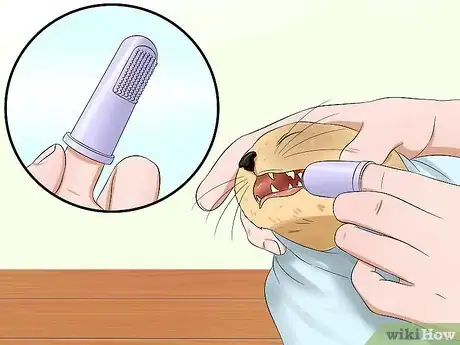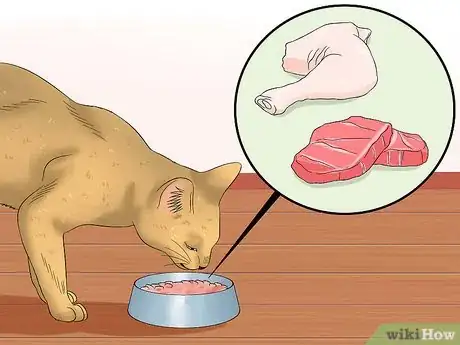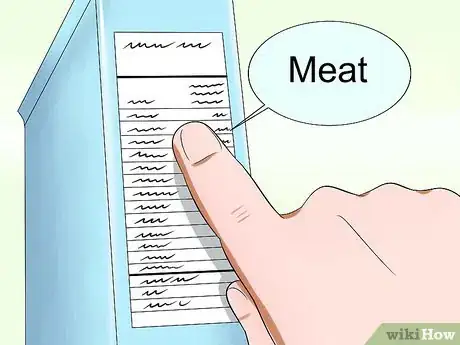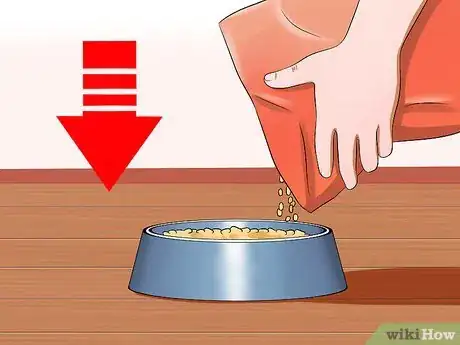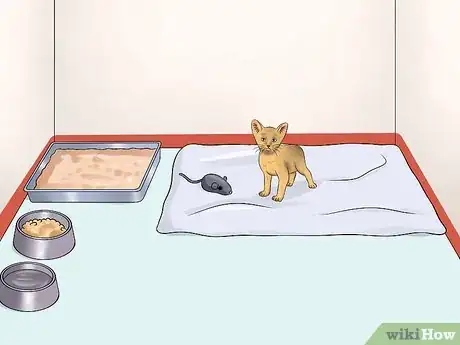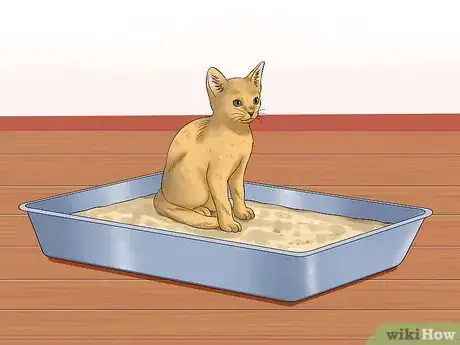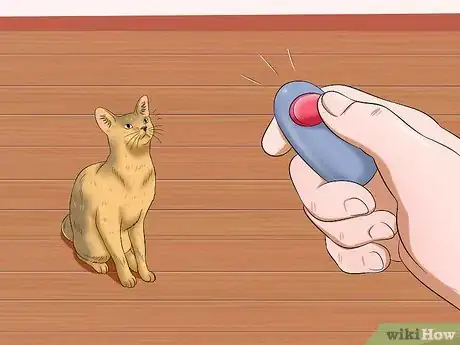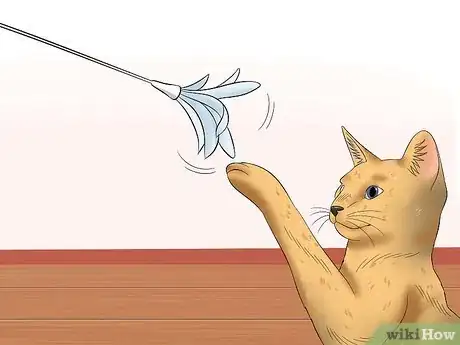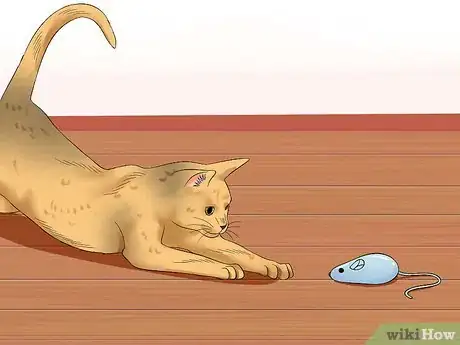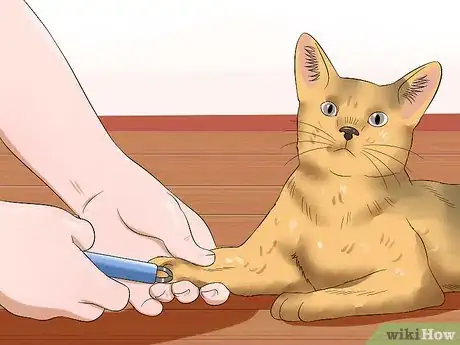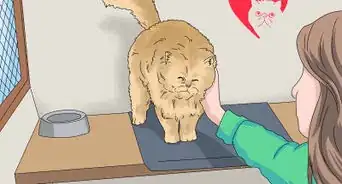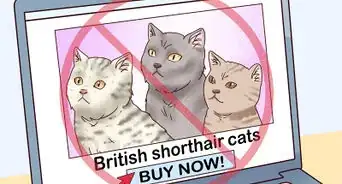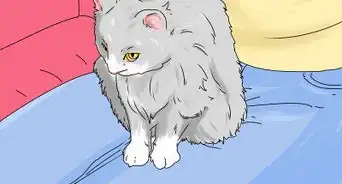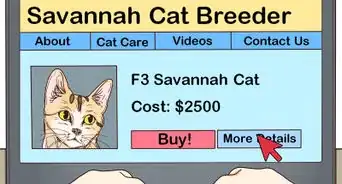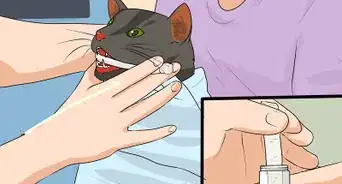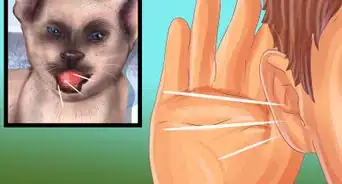This article was co-authored by Pippa Elliott, MRCVS. Dr. Elliott, BVMS, MRCVS is a veterinarian with over 30 years of experience in veterinary surgery and companion animal practice. She graduated from the University of Glasgow in 1987 with a degree in veterinary medicine and surgery. She has worked at the same animal clinic in her hometown for over 20 years.
There are 14 references cited in this article, which can be found at the bottom of the page.
This article has been viewed 20,610 times.
The Abyssinian cat is a long-legged, muscular, and short-haired cat that usually has a fawn-colored coat.[1] They are outgoing and active cats who love a lot of attention from their owners and are usually very smart. Like all cats, the Abyssinian cat needs proper care and nurturing to keep it happy and healthy.
Steps
Taking Care of Your Cat's Health
-
1Have a new cat screened for common diseases. When adopting a cat or kitten, have it looked over immediately for general health and breed-specific ailments. As a breed, the Abyssinian cat is prone to various diseases. This does not mean your Abyssinian will come down with a disease, as it may well live out a healthy disease-free life. However, it is wise to keep these tendencies in mind in case a problem arises. The diseases Abyssinians are prone to include:[2]
- Amyloidosis
- Heart disease
- Gum disease
- Nose polyps
- Myasthenia gravis
- Progressive retinal atrophy
- Psychogenic Alopecia
- Hyperesthesia Syndrome
- Hip Dysplasia
- Patellar (knee cap) luxation
- Congenital hypothyroidism (different from the more common hyperthyroidism in older cats)
-
2Get your cat regular veterinary exams. In order to find any disease or condition at its earliest stage, it is advised to have twice yearly veterinary exams.[3] Kittens generally see the veterinarian at least twice during the first three months of life, once more at around five to six months of age, and then follow the adult examination schedule.
- Your veterinarian will examine your cat thoroughly during the examination. This is the time to share any concerns or questions so they can be addressed promptly.
- Your Abyssinian’s vaccinations will be updated, and a fecal examination will be performed in order to check for internal parasites. Each community has their different requirements and need for vaccinations but the core vaccines are distemper and rabies.
- Feline leukemia vaccination may or may not be a part of its vaccinations depending upon your Abyssinian’s lifestyle. If your cat is an outdoor cat, has been in contact with lots of other cats (such as at a shelter), or has potentially been in contact with a cat you know has feline leukemia, then it should get vaccinated.[4]
Advertisement -
3Have your cat desexed. You will need to decide if you will have your Abyssinian spayed (female) or neutered (male). This important operation has the benefits of reducing reproductive tract diseases and roaming or heat activity. It is also a community service, as it will help reduce the overall population of unwanted cats.
- If you do not plan on breeding your cat, you should definitely have your cat spayed or neutered.
-
4Provide adequate dental care for your cat. Regular brushing reduces the plaque and buildup on the visible surfaces of the teeth. It’s a simple, quick process that, after the learning period, takes less than a minute a day. To do so you need a soft-bristled tooth brush and veterinary toothpaste, both which can be purchased at pet stores or a veterinary clinic. Human toothpaste cannot be used as the fluoride in it is toxic to cats. The process is:
- Place a small amount of the toothpaste on your fingertip and let your cat taste it.
- The following day do the same, then rub your finger along the cat's gums.
- The following day put the toothpaste on the brush and gently rub it along the cat's gums.
- For the next few days, slowly work the bristles along the teeth in small circles until your cat will sit still long enough for you to do the entire mouth.
Feeding Your Cat
-
1Feed your cat a meat-based diet. Proper feeding goes a long way to ensuring you have a healthy cat. Cats are obligate carnivores, which means they require certain amino acids that are only found in meat-based proteins. If they do not get these essential amino acids, they can acquire some serious preventable diseases.[5]
-
2Feed a good, quality food. Finding a good quality food can be a bit tricky, although all cat food manufacturers balance their food to meet a cat’s basic requirements. Ask your veterinarian for suggestions for cat food. You can also look at the food bag ingredient list. This will help you decide whether a food is good quality.
- If meat is the top two or three ingredients, it’s likely a good quality food. You want to avoid foods that have less than 40% protein (by weight) and look for foods that are grain free.[6]
- If you cannot find a quality canned or dry food, consider feeding your Abyssinian a raw diet. Commercially packaged raw foods are available at most pet stores and, while more expensive than traditional dry or wet foods, the food usually includes fewer unhealthy additives and ingredients.[7]
-
3Give your cat the right amount of food. You will see that the food bag label gives suggested amounts for feeding your cat. This is based on age, weight, and activity level. In general, cats prefer to eat frequent, small meals throughout the day.[8] Twice a day feeding will keep your Abyssinian full, satisfied, and hopefully not constantly begging for food.
Training Your Cat
-
1Introduce a new kitten or cat to its home gradually. When you bring your cat or kitten home, confine it to one room in the house with his litter box and food and water dishes to allow it to acclimate to its home in a quiet, unhurried manner. Of course, make sure you spend a few hours interacting with the cat to help him feel at home. After a few days, let your cat explore the rest of the house. If you have a kitten, you may want to keep it confined to the main level of the house until he can manage stairs on his own.
-
2Train your cat to use its litter box. Most cats are easy to potty train, as long as they know where their litter box is located and they are able to access it easily. One major choice you need to make is which type of litter to use. There are many types of litter available: clumping, clay, silica based, and plant based (such as pine or wheat).[9]
- You need to show your cat the litter box immediately when it arrives in your home. Cats tend to have a natural instinct to go to the bathroom in litter and usually are shown how to do it by their mother. By the time you bring home a kitten, it should have a good idea of what it is supposed to do. It just needs to know where the box is and it needs access to the box.
- Most cats prefer the fine-grained, unscented litters.[10] An unscented scoopable litter meets this standard, as it probably has a softer feel on its paws. However, you may find your cat prefers a different litter type, especially if it has used a particular style since kitten hood. If you find a litter that your cat likes, keep with that kind or your cat may decide to relieve itself elsewhere.
- Clean the box daily so your cat has a fresh, inviting bathroom.
-
3Teach your cat basic skills. While training a cat the same way as a dog is trained won't usually work, you can teach your cat some things. Teach it to play simple games and what it should, and shouldn't, scratch on. For example, set up an agility course for the cat in your living room and clicker train it to go through it.[11] You can even teach an Abyssinian to walk outside on a leash!
- Provide a scratching post. To keep your furniture and wood trim safe from cat scratching, provide your Abyssinian with a scratching post or similar item to scratch. Scratching is a normal, healthy activity to help remove the dead outer part of the claws, to let the cat mark its territory, and to give it necessary exercise.[12] If you catch your cat using a non-acceptable item as a scratching post, do not yell or hit the cat. Instead, pick it up and place it near the scratching post. To keep the cat from using unacceptable items you can use a cat deterrent spray, especially those with the smell of citrus, to keep them away from these items.
-
4Play with your cat. Abyssinian cats are very smart, and so they need to be entertained and stimulated mentally. This does not mean that the cat will always be in the mood to play with you, but you should try to when the cat acts interested.
- Laser pointer toys are a great way to exercise your cat. They are also a good way to have some fun with your cat.
-
5Provide stimulation for your Abyssinian, even when you are not home. Have a bunch of toys available to your cat, so that it hopefully plays with them instead of getting into trouble. Provide puzzle feeders and balls and mice to keep your cat occupied.
Grooming Your Cat
-
1Brush your cat regularly. Fortunately, the Abyssinian’s short, dense hair coat only needs a weekly brushing. Use a soft bristle brush or a slicker brush to gently brush your cat along with the direction that the fur is growing.
-
2Check your cat's body regularly. When you do brush, make sure to check the skin for any fleas, lumps, or bumps. If fleas are found, treat your cat immediately to control the problems. Any lumps or bumps should be noted for size, shape, and color. If it doesn’t resolve or grows within a week, contact your veterinarian.
-
3Maintain your cat's claws. Brushing time is also a good time to check its claws. If they are long and have sharp points, then it’s time to trim them. There are a variety of types and brands of cat nail clippers but most are either scissor type or guillotine type.[15] Whatever type you choose, avoid trimming the pink part of the nail as this is the blood and nerve supply. Cutting this part will cause bleeding and pain.
- Human nail clippers can be used on your cat’s nails to trim just the very tips off.
- To trim the nails, place the cat on your lap and place the forearm of your dominant arm on your cat’s upper body to gently restrain it. Use your non-dominant hand to pick up a paw and gently press on it to expose the claws. Your dominant hand is then used to trim the claws.
Expert Q&A
-
QuestionAre Abyssinian cats friendly?
 Pippa Elliott, MRCVSDr. Elliott, BVMS, MRCVS is a veterinarian with over 30 years of experience in veterinary surgery and companion animal practice. She graduated from the University of Glasgow in 1987 with a degree in veterinary medicine and surgery. She has worked at the same animal clinic in her hometown for over 20 years.
Pippa Elliott, MRCVSDr. Elliott, BVMS, MRCVS is a veterinarian with over 30 years of experience in veterinary surgery and companion animal practice. She graduated from the University of Glasgow in 1987 with a degree in veterinary medicine and surgery. She has worked at the same animal clinic in her hometown for over 20 years.
Veterinarian Yes, Abyssinian cats love the company of people and are friendly. However, for a 100% friendly cat, always make sure the breeder socializes the kittens well from a young age.
Yes, Abyssinian cats love the company of people and are friendly. However, for a 100% friendly cat, always make sure the breeder socializes the kittens well from a young age. -
QuestionHow long do Abyssinian cats live?
 Pippa Elliott, MRCVSDr. Elliott, BVMS, MRCVS is a veterinarian with over 30 years of experience in veterinary surgery and companion animal practice. She graduated from the University of Glasgow in 1987 with a degree in veterinary medicine and surgery. She has worked at the same animal clinic in her hometown for over 20 years.
Pippa Elliott, MRCVSDr. Elliott, BVMS, MRCVS is a veterinarian with over 30 years of experience in veterinary surgery and companion animal practice. She graduated from the University of Glasgow in 1987 with a degree in veterinary medicine and surgery. She has worked at the same animal clinic in her hometown for over 20 years.
Veterinarian The average lifespan of an Abyssinian is wide. It ranges from as few as nine years up to a respectable 15 years. Good preventative healthcare can help ensure your cat reaches the upper end.
The average lifespan of an Abyssinian is wide. It ranges from as few as nine years up to a respectable 15 years. Good preventative healthcare can help ensure your cat reaches the upper end. -
QuestionAre Abyssinian cats aggressive?
 Pippa Elliott, MRCVSDr. Elliott, BVMS, MRCVS is a veterinarian with over 30 years of experience in veterinary surgery and companion animal practice. She graduated from the University of Glasgow in 1987 with a degree in veterinary medicine and surgery. She has worked at the same animal clinic in her hometown for over 20 years.
Pippa Elliott, MRCVSDr. Elliott, BVMS, MRCVS is a veterinarian with over 30 years of experience in veterinary surgery and companion animal practice. She graduated from the University of Glasgow in 1987 with a degree in veterinary medicine and surgery. She has worked at the same animal clinic in her hometown for over 20 years.
Veterinarian Abyssinians are a bright, lively breed that need plenty of attention. When they get lots of playtime with their owner, they make a delightful pet that is not aggressive. However, if bored, they may redirect their energy into scratching or biting.
Abyssinians are a bright, lively breed that need plenty of attention. When they get lots of playtime with their owner, they make a delightful pet that is not aggressive. However, if bored, they may redirect their energy into scratching or biting.
Warnings
- Avoid feeding human food to your cat. Not only can it add too many calories some foods can be deadly to cats.⧼thumbs_response⧽
- If your cat is acting ill, contact your veterinarian for advice. Look for signs such as the cat is not eating or drinking, vomiting excessively, having diarrhea, excessively urinating or is unable to urinate, or is weak or has only lethargic activity. Cats are good at hiding illnesses, so if you see it acting ill it may have been ill for a while.⧼thumbs_response⧽
- Never change a cat's food abruptly, as it can lead to an upset stomach. If you must change the cat's food, do it gradually. Add the new food to the old food over the course of a week.⧼thumbs_response⧽
References
- ↑ www.cfa.org/Breeds/BreedsAB/Abyssinian.aspx
- ↑ www.vcahospitals.com/main/cat-care/cat-breeds/abyssinian
- ↑ http://www.vcahospitals.com/main/cat-care/cat-breeds/abyssinian
- ↑ http://pets.webmd.com/cats/facts-about-feline-leukemia-virus?page=2
- ↑ Differences between cats and dogs: a nutritional view. 7. Veronique Legrand-Defretin (1994). Proceedings of the Nutrition Society, 53, pp 15-24. doi:10.1079/PNS19940004.
- ↑ http://aksumabyssinians.com/abys.html#nutrition
- ↑ http://aksumabyssinians.com/abys.html#nutrition
- ↑ The Evolutionary Basis for the Feeding Behavior of Domestic Dogs (Canis familiaris) and Cats (Felis catus) John W.S. Bradshaw The Journal of Nutrition. July 2006 vol. 136 no. 7 1927S-1931S
- ↑ www.petmd.com/cat/centers/litter/evr_ct_clumping-versus-non-clumping-cat-litter#
- ↑ http://www.humanesociety.org/animals/cats/tips/preventing_litter_box_problems.html
- ↑ http://www.vetstreet.com/cats/abyssinian#personality
- ↑ www.humanesociety.org/animals/cats/tips/destructive_scratching.html
- ↑ http://www.pethealthnetwork.com/cat-health/cat-breeds/abyssinian-cat
- ↑ http://www.purina.com.au/owning-a-cat/cat-breeds/abyssinian
- ↑ www.vetmed.wsu.edu/ClientED/cat_claws.aspx
About This Article
To care for an Abyssinian cat, feed it a high quality meat-based diet, since this will provide essential amino acids that prevent serious diseases. If you’re not sure what to feed your cat, ask your vet or look for food where meat is the top 2 to 3 ingredients, since this is likely to be high quality. Additionally, since Abyssinian cats are very smart and energetic, you should play with it or provide toys for stimulation when you’re not home. To groom your cat, brush it once a week using a soft bristle brush in the direction that its fur grows. For more advice from our Veterinary co-author, including how to maintain your cat’s claws, keep reading!
